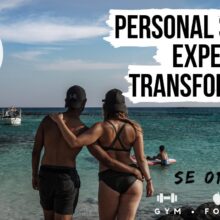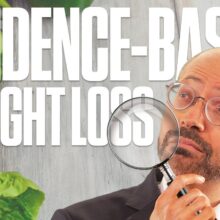Hello Health Champions today we’re going to talk about the best way to lower blood sugar and the first thing we have to understand is of course what is normal blood sugar what are we trying to accomplish here and the traditional view the recommendations are that a normal blood sugar when
00:00:19
you’re fasting meaning when you haven’t eaten any food for about 12 hours should be between 70 and 100 and I can basically agree with those numbers I think we need to tighten it up a little bit and I’ll talk about that but I can basically agree with that then they talk about impaired glucose
00:00:40
regulation and that’s when you’re a little insulin resistant and you may be pre-diabetic and now your fasting glucose would be 101 to 125 if you are a type 2 diabetic then it’s gone a little bit further and your fasting glucose is 126 and up but we also want to understand a little bit more about
00:01:02
the Dynamics how quickly does glucose go up after we eat and how long does it take for it to come down and how long should it take so basically what they’re saying is that 30 minutes or so whenever you have your Peak which could be 30 maybe a little bit longer depending on what you eat
00:01:22
you should not get over 170 to 200 and I think that’s an absolutely crazy range I’m going to talk about that but I believe that most of those people who get their glucose that high they’re eating garbage they’re eating processed carbohydrates and they are already insulin resistant they should
00:01:45
not get that high they’re saying that if you are insulin resistant pre-diabetic then it could get 190 to 230 and if you’re a type 2 diabetic it would get to 220 to 300. so those would be the highest numbers and then we want to look at after it’s starting to come down two to three hours
00:02:06
later when the body has had some time to process this then they want the normal people if you’re healthy have good glucose regulation they say it should be 120 to 140. so basically anything that comes down under 140 would be normal if you are impaired insulin resistant then it would be 140
00:02:27
to 190 and if you type 2 diabetic then it wouldn’t get under 200 within that time frame because when you’re insulin resistant the insulin is very poor in getting that glucose out of the bloodstream but I believe that a lot of the people included in the normal category here are not all that healthy so
00:02:49
it’s not really normal it’s just common and we have to keep in mind that 88 of the population have some degree of insulin resistance so when we’re talking about optimal numbers then those ranges are going to get much tighter I believe a fasting number should be about 80 to 90 and
00:03:10
I think if you’re doing a long-term fast or if you’re on keto then it’s okay to be a good bit lower than the 80 also I think if you’re doing a three day fast I think you can get into the 50 fees and that’s still perfectly normal because when you’re making more ketones you don’t need
00:03:28
that much blood glucose but the next one is where the numbers are really different from the standard numbers because I believe that even after a meal you should stay between 90 to 110 and if you probably have noticed this if you’re eating low carb if you’re doing keto then your
00:03:48
numbers probably don’t change much at all and for some people who have noticed the dawn phenomenon they might wake up with a little bit higher blood sugar that stays High until they eat and then it actually comes down and if you’re eating whole food and you’re not eating a bunch of processed
00:04:08
carbs then you’re probably going to notice that there’s very very little change and then two to three hours later you’re probably going to find that you’re back on a baseline so these huge shifts I do not think are normal or healthy and I want to look at it one more way here that if
00:04:28
we look at it graphically then what they call normal is with blood sugar almost doubling and again I think that’s because people are eating a lot of junk they’re eating a lot of sugar and they have been told that most of their food most of their caloric intake should be from carbohydrate
00:04:51
and they’re told that complex carbohydrates are good for them but they actually are nothing but sugar in a different form which we’ll talk about in a second if you’re a bit insulin resistant then the graph would shift up a little bit the yellow if you’re a diabetic it would shift even higher
00:05:11
but again the huge difference is where I believe the optimal numbers should be almost a flat line if you eat real food there really should not be much difference at all the next question we want to ask is what causes high blood sugar and of course that has a lot to do with if we eat
00:05:30
something food intake but what we eat plays a huge role so carbohydrates tend to raise blood sugar much much more many many times more especially processed carbohydrates and the worst form of carbohydrates are called sugar and high fructose corn syrup they’re very similar but high fructose
00:05:52
corn syrup is even worse because it has more fructose which clogs up the liver which we’ll talk about and it is also even faster in getting into the bloodstream and affecting blood sugar but the next one we want to understand properly and that’s called starch because we hear so much about
00:06:13
carbohydrates being necessary and sugar is bad but complex carbohydrates are supposed to be good so that is a huge myth so not everyone needs to avoid carbohydrates so strictly but if you are insulin resistant then you need to eat less carbohydrates and there is no difference in how these
00:06:38
carbohydrates affect blood sugar and the starches will turn into glucose almost instantaneously so here’s what we need to understand about carbohydrates and glucose that glucose is a ring it has six carbons in it and that is the molecule that swims around in the bloodstream that we call
00:07:02
blood sugar most of the carbohydrates that we eat are simply glucose linked together and if we link hundreds of these together then it’s called starch so once we get that into the body as soon as you put it into the mouth there is an enzyme called amylase salivary amylase that starts breaking
00:07:29
up these bonds so it’s going to chop off these two by two and then a little bit later we chop them up one by one and now they are free to get into the bloodstream and this is why starches like potato and rice and bread will raise blood sugar very very quickly even faster than white sugar itself
00:07:53
now the reason that sugar is worse is that sugar has the glucose ring just like starch does but then the second ring is a little bit different it is called fructose it still has six carbons but it’s shaped a little differently configured a little bit differently so the only place that
00:08:18
fructose can be processed is in the liver so one we have these glucose they get chopped up they become blood glucose and they can be used by every cell in the body but with the sugar there’s 50 percent glucose and 50 fructose so if you eat a hundred grams of sugar you’re gonna have
00:08:43
50 grams of glucose that can be used by every cell in the body if you eat a hundred grams of starch there’s a hundred grams of glucose that can be used by every cell in the body but this fructose if you eat 100 grams of sugar there’s 50 grams of fructose that can only be processed by the liver
00:09:07
and the liver is a lot smaller than the rest of your body so these 50 grams has to be processed by three pounds of liver tissue they have to try to metabolize that and repackage it so what happens is whatever the liver can’t use when it gets overloaded gets turned into fat
00:09:29
and that is the number one cause of fatty liver so when you hear people talk about non-alcoholic fatty liver disease that is caused by fructose it used to be only alcoholics could get fatty liver almost all the cases of fatty liver was called afld alcoholic fatty liver disease but
00:09:54
today the vast majority of fatty liver is caused by fructose so it’s non-alcoholic so this is why starches are bad if your carbohydrate intolerant if you have an impaired ability to deal with carbohydrates then starches are bad but sugar is worse because the glucose portion will raise blood
00:10:19
sugar but then the fructose portion will clog up the liver and once that liver is clogged up that liver is insulin resistant and that kind of sets the tone for the rest of the body so carbohydrates have by far the greatest impact on blood sugar but protein also has some impact on blood sugar and
00:10:41
the reason is that protein can be converted into glucose down the line now protein the purpose of protein is to build tissue as we have cells and tissue that wears out there is a turnover and the old ones get broken down and we have to have new protein to build up the new ones so most of the
00:11:06
protein is intended to become tissue but if we eat more protein than what we need then the rest of it the excess gets turned into glucose because we can’t store protein protein becomes tissue there is no storage system for protein other than what naturally occurs in the bone and the muscles and
00:11:30
the skin and so forth and whatever we don’t use for tissue is left over and that gets turned in to glucose now that is the better version of of carbohydrate so glucose is better than fructose so protein gets turned into glucose it cannot become fructose and clog up the liver so the impact is
00:11:56
slight compared to carbohydrates and then we have fat and fat will also affect glucose a little bit indirectly so the fat itself the fatty acids can not ever become glucose or fructose it cannot turn into a carbohydrate however the way that animals like humans and the animals that we eat for food
00:12:23
the way that they store fat is as triglycerides and that means that there’s three fatty acids connected to a glitter glycerol backbone and this glycerol backbone is about five percent of the calories in the fat that’s stored and that glycerol can be turned in to glucose but again it
00:12:47
happens down the road it happens to a smaller degree and it happens very very slowly so that is why when we eat a high fat low carb diet that the impact on blood sugar is almost zero and if we look at it visually in terms of carbohydrates affecting blood glucose that would look like
00:13:08
this big Arrow the protein would look like a much smaller arrow and the fat Arrow we can barely see so if we want to put some numbers then this would be about 70 to 100 the protein would be in the teens so 10 to 15 maybe 20 and fat would be single digits low low single digits when we eat those
00:13:34
by themselves so in the short term the greatest impact on blood sugar is the type of foods that we eat but in the long term the greatest impact is on how the different types of foods affect insulin so the second factor that affects blood sugar is insulin resistance and here’s how that works when
00:13:56
you eat food like we said especially carbohydrate then your blood glucose will increase because this food that you just ate has to be absorbed into the bloodstream and pass through the bloodstream into the cells and the thing that helps that makes this blood glucose get from the bloodstream into
00:14:19
the cell is called insulin and if we have the higher the blood glucose we have the higher the insulin response if we have mostly fat in the diet then blood glucose barely goes up at all and we barely have to have an insulin response if we drink high fructose corn syrup in a soda
00:14:42
then our blood glucose is going to go through the roof very quickly and then the insulin has to be very high in response to that so in a sense this insulin is pushing or even forcing the blood glucose out of the bloodstream and into the cell and this is a good thing because that what needs
00:15:02
to happen however if we do that every day like if we did it once a month then it wouldn’t be a big deal but once we start doing it on a regular basis now the cells start to resist having that Sugar forced into the cell they’re saying we’ve got a good amount we keep getting more and more but
00:15:26
there’s a limit we we’ve had it please back off stop pushing sugar in so the cells become insulin resistant over time and we’ll talk a little bit more about this that that doesn’t happen overnight but now that the cells are insulin resistant they’re resisting the action of insulin which is
00:15:48
to get the blood sugar out of the bloodstream when the cells are insulin resistant now the insulin isn’t working anymore so we get higher blood sugar so now we’re stuck in a loop where higher blood sugar leads to more insulin which leads to more insulin resistance which leads to higher blood
00:16:11
sugar and so on and so on and anything that raises blood sugar will contribute to this Loop but like we said there are a couple of things that are even worse so sugar is 50 percent fructose so the sugar will increase blood glucose will increase insulin but the fructose like we said it will tend to
00:16:41
clog up it will tend to overwhelm the liver and cause insulin resistance by a different mechanism so carbs causes blood sugar causes insulin but fructose is kind of the last nail in the coffin if you will and again we need to understand that the insulin response is proportional to the increase
00:17:05
in blood glucose and just like carbohydrates cause the greatest increase in blood glucose they also cause the greatest insulin response protein is much less and fat is almost zero and then there’s some good news and some bad news so it takes a long time to break it what does that mean what
00:17:28
are we breaking well think of your body as a machine that has a certain capacity to process things and one of those things is carbohydrates and depending on our lifestyle and what we eat we will tend to wear out that machine and a lot of that is going to be genetically determined so
00:17:47
some people might have this much capacity before the machine machine wears out and some people might have this much but it’s still the lifestyle that wears it out and then once that machine is broken then you have what’s called a carbohydrate intolerance your body just doesn’t know what to do
00:18:07
with carbohydrates it doesn’t have the Machinery in place to process it and this way of thinking is very poorly understood because a lot of people will say but I didn’t change anything I had my my I ate the same stuff my blood sugar was good for 20 years and then all of a sudden it went crazy
00:18:27
and I was diagnosed with diabetes so what we need to understand is that the flaw in the traditional way of diagnosing and looking at blood sugar is that we’re only measuring blood sugar we’re not measuring the thing controlling blood sugar and blood sugar is a very tightly controlled variable
00:18:48
because it’s super important for for the brain to function to keep the blood sugar in that narrow range if it gets too high the brain suffers it gets inflamed we can even get into a coma if it gets too low we can also get into a coma so the glucose it’s super important to keep it tight
00:19:07
and therefore it is very tightly controlled and if we have stable blood sugar and we eat whole food then it doesn’t take much effort it doesn’t take much insulin to keep the blood sugar in that range so let’s say that we start off in year one and we have a certain amount of glucose and at
00:19:30
the same time it takes an equal or a comparable proportional amount of insulin to control that so we have a certain amount of insulin and we have a certain amount of glucose and we’re healthy we’re in Balance we’re insulin sensitive but then time goes on time March is on and a few years later
00:19:55
we go in we get the measurements and glucose is still good but insulin has doubled so now the body has to work twice as hard at controlling at regulating and keeping that glucose in that tight range and if we only measure glucose then we’ll never find out but if we measure insulin
00:20:18
we see hey you know it’s something’s changing the cells are becoming more insulin resistant so the body has to work harder so then time goes on and a few years later now it takes four times as much it’s doubled again and still the glucose level is about the same and then finally
00:20:45
the machine breaks and this might be 20 years down the road you can break it faster with lots and lots of soda there are even kids that get this but for the most part we’re talking decades for this to develop and now we might have insulin levels that are way way up so if you notice
00:21:08
the glucose is a controlled variable so it only changes when the machine has broken or is about to break when the system is very very resistant but if we measure insulin then we see that it’s a more linear function so we can pick that up much much sooner so that’s the good and the bad news
00:21:35
the good news is that it takes a long long time to break it the bad news is that if we don’t measure the right things then we discover it 20 years too late and another piece of good news is that even if it takes this long to break it it’s a whole lot faster to heal it if it takes 20 years to
00:21:59
break it you can probably reverse most of that in just a few months now that doesn’t mean that it’s completely reversed it means it’s under control and it’s moving in the right direction action but when you have this much momentum the body has certain set points and certain memories and it
00:22:18
might take a good while to reverse that momentum and get truly back to Baseline so now that we understand the mechanisms we understand what sugar is we understand what starch is we understand how insulin works and the different mechanisms now we can stop listening to The Standard guidelines of
00:22:37
eating low-fat and high carb because that’s going to make the problem worse it may work for a person who is athletic and young and insulin sensitive but if you are insulin resistant and you follow the guidelines for how to eat you will get worse it will move you from pre-diabetes to diabetes
00:22:57
so the number one thing we want to do when we’re going to lower blood sugar is to understand that it’s primarily about insulin because insulin resistance will drive up the blood sugar once you are in insulin resistant you don’t have the capacity to regulate blood sugar and carbohydrate
00:23:17
so you have to cut them way back but it is primarily about lowering the insulin so the body can get back to balance and the most important thing if you want to lower your insulin is to stop eating sugar because sugar is 50 percent fructose 50 glucose the glucose will raise blood sugar and
00:23:39
drive insulin and the fructose will cause insulin resistance by clogging up the liver and causing a fatty liver and the next thing we want to do is to reduce overall carbohydrates because all carbohydrates turn into sugar when we break down the carbohydrates the plant food the starches they
00:23:59
turn into sugar they drive up blood sugar but that doesn’t mean you can’t eat any plant food or any carbohydrates I believe that you should eat a lot of plant plant food you just have to know which ones to eat and what you want to eat a lot of are leafy greens and non-starchy vegetables because if
00:24:21
you eat things like broccoli and cauliflower and leafy greens now they’re mostly water they’ll have two to three to four percent carbohydrate which is mostly sugar but because there’s so much water and there’s some Fiber that Sugar which is a very small amount also gets absorbed very slowly so you
00:24:42
can be on a ketogenic diet and eat many many cups of non-starchy vegetables and leafy greens the carbohydrates that cause the problems are the high starch so we’re talking about grains potatoes corn etc those are the ones you want to avoid but you can have a lot of non-starchy vegetables and step
00:25:06
number four would be to eat fewer meals that’s going to help tremendously because what you’re trying to do is to lower insulin so one thing you can do is to eat foods that stimulate less insulin but when you’re fasting when you eat no food then there is no additional insulin there’s
00:25:27
just like a trickle of insulin for your Baseline blood sugar but you’re not putting any new food in so there’s no need for a mass effort to produce insulin another thing you can do to help out is gentle exercise and you do want it to be gentle a lot of people are confused here because they think
00:25:49
it’s all about calories and they think if you burn off the blood sugar with intense exercise then you’ll bring it down faster but that’s not true because when you do intense exercise then you also produce cortisol which raises blood sugar because with intense exercise your body
00:26:09
is kind of in a state of urgency and it’s going to try to bring up the blood sugar with breaking down glycogen with making new glucose through gluconeogenesis but when you do gentle exercise now what’s going to happen is you’re going to burn mostly fat because with gentle with a low
00:26:33
Baseline you can provide enough oxygen and when you can provide enough oxygen you burn primarily fat you’re still going to burn through some of the glucose and it will help bring down the glucose but you still want to stay in fat burning and what happens then is that the muscles basically
00:26:53
act like sponges they’re going to suck up the glucose from the bloodstream because when a muscle is exercising it doesn’t need insulin a muscle at rest requires insulin to get the glucose into the muscle but when it’s working those floodgates those portals open up anyway and what happens
00:27:17
with intense exercise is that you’re not using more fat but you’re switching to more glucose you always burn a combination of both but with gentle exercise it’s more fat with intense exercise it’s more glucose and what happens then is that you create a need for the body as you’re burning
00:27:38
through more glucose the body will make more glucose and because you put it in that sense of to master Health by understanding how the body really works make sure you subscribe hit that bell and turn on all the notifications so you never miss a life-saving video
https://www.youtube.com/watch?v=aAysDp5fNDM
Source : Youtube






